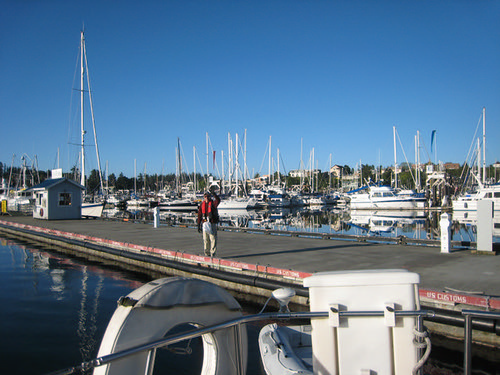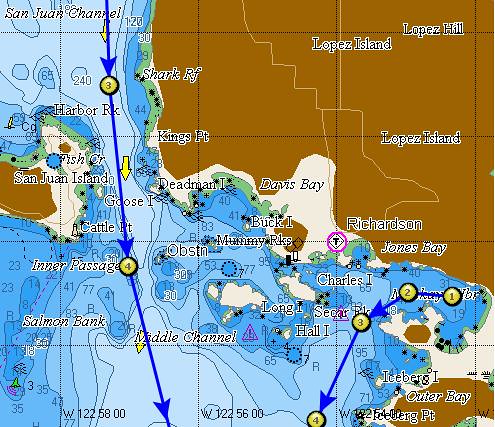I first single handed our 35' Wauquiez Pretorien from Friday Harbor, WA across the Strait of Juan de Fuca to Port Townsend, WA and then on to Edmonds, WA. I was nervous and spent a great deal of time focusing on heavy weather, sail plans, solo anchoring and potential in-boat emergencies.
To avoid solo docking which I had not yet practiced, my husband sailed with me from Sidney BC to Friday Harbor to clear customs and my father arranged to meet me at the docks in Kingston, WA where I would touch-and-go to pick him up before heading into the Edmonds marina. I planned an overnight stop on anchor at Port Townsend.
I left my husband Carol at the customs dock in Friday Harbor after anchoring out overnight in the harbor:

Just South of Friday Harbor in San Juan Channel I saw a fog bank in front of me:

Here is where I went wrong. I should have gone back to Friday Harbor and waited out the fog. Instead, I thought I would go "through it". Of course, there is no "through it". There is more fog.
So with radar, my fog horn, and Navsim electronic charting software I emergency navigated into MacKay Harbor.
Our GPS antenna which had been sporadically losing connection began sporadically losing connection while in the narrowest part of San Juan channel. I could see other boats, mostly small fishing vessels, on radar but my visibility was down to a few boat lengths. I honked my horn at any contact and spent that hour running up and down to the radar screen at the nav table and back to the cockpit.
I used the radar to complement my electronic charts to verify that I was, in fact, where I thought I was in the channel because I could not see the sides. I also used the radar to verify my route through the rocky islands.
You can see my planned route due South and, after anchoring, my new route out of MacKay Harbor:

In addition to radar, electronic charts and my fog horn I also hoisted our radar reflector and called my husband to give him my coordinates and the situation.
Once inside MacKay Harbor I dropped anchor in the relative middle of the harbor without bothering to set it (no wind) and sat in the cockpit reviewing what had happened. I made a time estimate on getting to Port Townsend before dark and decided that if the fog had completely cleared before early afternoon I would peek out of the harbor and if the fog had completely cleared in the Strait of Juan de Fuca I would continue to Port Townsed.
Here is the bank of the harbor from where I dropped anchor in fog:

Several hours later, this is the same view of the harbor as I left it in the sun:

The fog lifted and I crossed the Strait anticlimactically. No wind and a sunny motor to Port Townsend where I dropped anchor for the second time that day by myself. I spent a nice night there and then motored in no wind to Kingston where I did a touch-and-go pick up of my father at Kingston and he helped me dock in Edmonds, WA.
Overall single handing was pivotal. I feel more in control of the boat and a lot more confident in my own skills. Although the fog was an unnecessary risk not to be repeated, it showed me how much I've learned about radar and navigation generally. I have a sense of where and in what conditions I can anchor by myself and at least "un-dock" the boat by myself which I did several times.
Lessons learned:
- If you are in a safe place and there is fog ahead of you, stay put. If you have an avenue of retreat, and there is fog ahead of you, go back to a safe place and wait it out.
- If a safety or navigation item in your boat is in need of repair, either repair it or make sure a good spare is handy. We should have fixed our GPS antenna line earlier and if not, we have a handheld GPS and should have had it handy instead of my having to dig it out while simultaneously doing a dozen other things.
- Don't let stressors (like heavy weather) stop you from thinking clearly about other factors. In other situations this lesson has helped us remember that when we are stressed about a situation, such as docking in a tight spot, that those are particularly good moments to go through all of the safety items needed but not at the top of your mind, such as PFDs, turning down the VHF radio, etc.
Years ago when I was a kid, I used to read Flying magazine. I particularly enjoyed a long-running series of articles entitled "I Learned About Flying From That." Each article was written by a pilot, who humbly admitted to having made a mistake, and then having lived, told about it in the hopes that others would not have to make the same mistake. I thought then that it was a good format, and I still think that now. This series of postings is my attempt to recreate that article series with a new subject and new technology.
(If you would like to help others to learn from your mistakes, please send your article to: WindborneInPugetSound at gmail dot com)










No comments:
Post a Comment